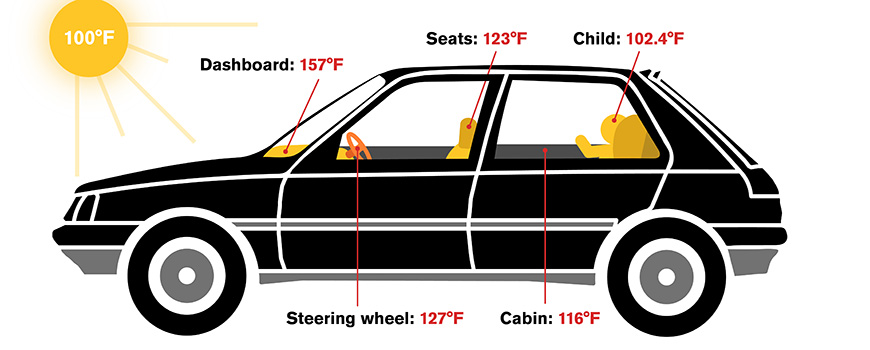Global S&T Development Trend Analysis Platform of Resources and Environment
| Research Highlight: Hot Cars Can Hit Life-Threatening Levels in Approximately One Hour | |
| admin | |
| 2018-05-25 | |
| 发布年 | 2018 |
| 语种 | 英语 |
| 国家 | 美国 |
| 领域 | 资源环境 |
| 正文(英文) |  Illustration of car interior temperatures. Image: Arizona State University Six children have died from being left in hot cars in the United States so far this year, according to the web site Noheatstroke.org. That number will likely rise with looming summer temperatures. On average, 37 children in the US die each year due to complications of hyperthermia – when the body warms to above 104° Fahrenheit and cannot cool down – after being trapped in overheated parked cars. Researchers from University of California San Diego and Arizona State University found that if a car is parked in the sun on a summer day, the interior temperature can reach 116° F. and the dashboard exceed 165° F. in approximately one hour – the time it can take for a young child trapped in a car to suffer fatal injuries. The study, published May 24 in the journal Temperature, compared how different types of cars warm up on hot days when exposed to different amounts of shade and sunlight over different periods of time. More importantly, the researchers also took into account how these temperature differences would affect the body of a hypothetical two-year-old child left in a vehicle on a hot day. “Young children are vulnerable to the impacts of extreme heat with increased emergency department visits found during heat waves. Internal injuries can begin at temperatures below 104°,” said first author Jennifer Vanos, PhD, assistant professor in the Department of Family Medicine and Public Health and Scripps Institution of Oceanography at UC San Diego. “As compared to adults, children have a quicker rise in core temperature and a lower efficiency at cooling.” Researchers used six vehicles for the study: two identical silver mid-size sedans, two identical silver economy cars and two identical silver minivans. During three summer days in Tempe, Arizona with temperatures in the 100s, researchers moved the cars from sunlight to full shade (under solar panels) for different periods of time. “We’ve all gone back to our cars on hot days and have been barely able to touch the steering wheel,” said Nancy Selover, study co-author, climatologist and research professor in the School of Geographical Sciences and Urban Planning at Arizona State University. “Imagine what that would be like to a child trapped in a car seat on a hot day either in the sun or shade.” The researchers found that for vehicles parked in the sun during a simulated shopping trip, the average temperature inside the vehicles hit 116° F., dashboards 157° F., steering wheels 127° F. and seats 123° F. in one hour. For vehicles parked in the shade, interior car temperatures were closer to 100° F., dashboards averaged 118° F., steering wheels 107° F. and seats 105° F. after one hour. “We found that a child trapped in a car under the study’s conditions could reach a body temperature of 104° F. in about an hour if a car is parked in the sun, and just under two hours if the car is parked in the shade,” said Vanos. “This body temperature could be fatal to infants and children – and those who survive may sustain permanent neurological damage.” More than 50 percent of cases of a child dying in a hot car involve a parent or caregiver who forgot the child in the car. “Children and infants are unable to control the environment, communicate well and often fall asleep during car rides,” said Vanos. “Even in our technologically advanced world, human error results in children dying every year in the US from being left in hot vehicles – all of which is 100 percent preventable.” The different types of vehicles tested in the study warmed up at different rates, with the economy car warming at the fastest rate and the minivan the slowest due to relative air volumes. However, when addressing the overall heat gain from temperature, radiation and other factors, a person’s age, weight, existing health problems and other factors, including clothing, will affect how and when heat becomes deadly.= Vanos and the research team hope these findings will result in new behavioral and technological interventions that will save the lives of the most vulnerable car passengers.
- UC Health Sciences and Robert Monroe
This story appears in explorations now, Scripps Institution of Oceanography's award-winning ocean and earth science magazine. Sign up to receive our free monthly story roundup.
|
| URL | 查看原文 |
| 来源平台 | Scripps Institution of Oceanography |
| 文献类型 | 新闻 |
| 条目标识符 | http://119.78.100.173/C666/handle/2XK7JSWQ/107394 |
| 专题 | 资源环境科学 |
| 推荐引用方式 GB/T 7714 | admin. Research Highlight: Hot Cars Can Hit Life-Threatening Levels in Approximately One Hour. 2018. |
| 条目包含的文件 | 条目无相关文件。 | |||||
| 个性服务 |
| 推荐该条目 |
| 保存到收藏夹 |
| 查看访问统计 |
| 导出为Endnote文件 |
| 谷歌学术 |
| 谷歌学术中相似的文章 |
| [admin]的文章 |
| 百度学术 |
| 百度学术中相似的文章 |
| [admin]的文章 |
| 必应学术 |
| 必应学术中相似的文章 |
| [admin]的文章 |
| 相关权益政策 |
| 暂无数据 |
| 收藏/分享 |
除非特别说明,本系统中所有内容都受版权保护,并保留所有权利。
修改评论